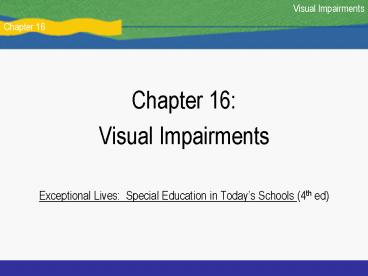Visual Impairments PowerPoint PPT Presentation
1 / 9
Title: Visual Impairments
1
Visual Impairments
Chapter 16
- Chapter 16
- Visual Impairments
- Exceptional Lives Special Education in Todays
Schools (4th ed)
2
How Do You Recognize Students with Visual
Impairments?
How Do You Recognize Students with Visual
Impairments?
Defining Visual Impairments
- Two different definitions
- Legal definition
- Based on acuity and field of vision
- 20/200 (legally blind)
- Field of vision is less than 20 degrees (tunnel
vision) - IDEA definition (educational performance is
affected) - Low vision generally read print with the use of
optical aids, use vision for learning, may or may
not be legally blind - Functionally blind typically use braille, may
use vision for moving through environments or
sorting items by color - Totally blind do not receive meaningful input
through the visual sense and generally use braille
Understand the definition and characteristics of
students with visual impairments.
3
How Do You Recognize Students with Visual
Impairments?
Describing the Characteristics
- A large number also have severe and multiple
disabilities - Incidental learning
- The way sighted children naturally learn about
their environment - Lack of incidental learning skills can impact the
development of motor, language, cognitive, and
social skills - Limitations in range and variety of experiences
- Some objects are difficult to describe by touch
only or are not able to be touched (for example,
skyscrapers or mountains) - Limitations in the ability to get around
- Can impact a childs motor development since they
often become passive - Limitations in interactions with the environment
- Being unable to determine detailed information
about their environment, they may be unable to
learn appropriate reactions to environmental
stimuli
Understand the definition and characteristics of
students with visual impairments.
4
How Do You Evaluate Students with Visual
Impairments?
How Do You Evaluate Students with Visual
Impairments?
Determining the Presence
- Causes
- Congenital occurs at birth
- Adventitious acquire a vision loss later in
life - Determining how a student uses vision
- Functional vision assessment (FVA)
- Provides more concrete information about a
students vision that may help in making IEP
decisions - Determining the appropriate reading medium
- Finding the appropriate learning medium
- Braille, print, audiotapes, and access technology
- Allows the IEP team to know what accommodations
are needed
Develop an understanding of the needs of students
with vision impairments within the classroom
context.
5
Figure 16-3
How Do You Recognize Students with Visual
Impairments?
Identifying the Causes Prevalence
Develop an understanding of the needs of students
with vision impairments within the classroom
context.
6
How Do You Recognize Students with Visual
Impairments?
Determining the Nature and Extent of Services
- Services must be based on a students specific
needs as identified through assessment - Assessment team must include an orientation and
mobility specialist and teacher for students with
vision impairments - Informal assessments should include the students
ability to function independently outside the
classroom and within the community - Assessments should include the age-appropriateness
of tasks - What are the students peers doing?
- Determine skills typically learned through
incidental learning, analyze task involvement,
and begin teaching these tasks earlier - Teachers should not make assumptions about a
students previously acquired learning (due to
the problems with incidental learning) - Provide extra time for standardized tests
Develop an understanding of the needs of students
with visual impairments within the classroom
context.
7
How Do You Assure Progress in the General
Curriculum?
How Do You Assure Progress in the General
Curriculum?
Including Students
- Blindness does not affect what a student can
learn as much as how a student can learn. - Students with the most intensive educational
needs may attend residential schools most can be
included in general education classroom with
supports. - There is a long history of including students
with blindness in general education settings.
Develop an understanding of the needs of students
with visual impairments within the classroom
context.
8
How Do You Assure Progress in the General
Curriculum?
Planning Universally Designed Learning
- Adapting instruction
- Adapted methods to access to print
- Augmenting instruction with additional meaningful
experiences - Opportunities to use assistive technology
- Provision of specialized instruction and
materials - Tactual/kinesthetic approach
- Augmenting curriculum
- Daily living skills effective teaching
strategies involve repeated visual or
hand-over-hand kinesthetic demonstrations,
systematic instruction, gradual fading, and
significant practice. - Orientation and mobility (an IDEA related
service) teaches students to know where they are
in their environment and how to move around that
environment safely. - Self-advocacy most people with visual
impairments are required to explain their
abilities and special needs to other people they
meet bus drivers, prospective employers, etc.
Recall the assistive technologies available to
support appropriate curricular and instructional
needs of students with visual impairments.
9
Assistive Technology
Technology
- JAWS speaks the text on the monitor aloud
- Braille n Speak
- Synthesized voice output
- Braille translation software
- Page 475 (Box 16-5)

